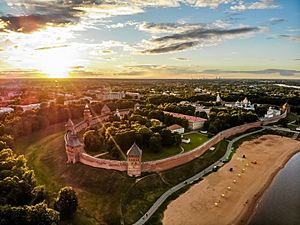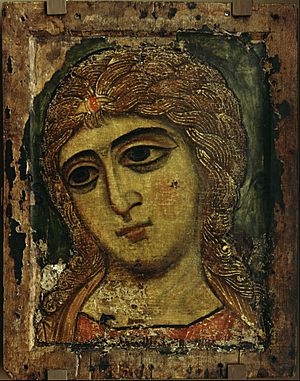Veliky Novgorod facts for kids
Quick facts for kids Veliky Novgorod (English)Великий Новгород (Russian) |
|
|---|---|
| - City - | |
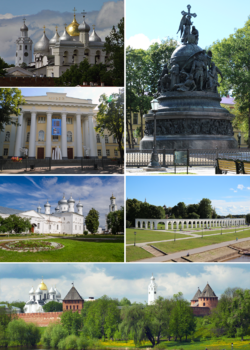 Counter-clockwise from top right: the Millennium of Russia, cathedral of Saint Sophia, the fine arts museum, St. George's Monastery, the Kremlin, Yaroslav's Court |
|
|
|
|
| Administrative status | |
| Country | Russia |
| Federal subject | Novgorod Oblast |
| Administratively subordinated to | city of oblast significance of Veliky Novgorod |
| Municipal status | |
| Urban okrug | Veliky Novgorod Urban Okrug |
| Mayor (Head) | Aleksandr Rozbaum |
| Representative body | Duma |
| Statistics | |
| Area | 90 km2 (35 sq mi) |
| Population (2010 Census, preliminary) |
218,717 inhabitants |
| - Rank in 2010 | 85th |
| Population (January 2011 est.) | 218,681 inhabitants |
| Density | 2,430/km2 (6,294/sq mi) |
| Time zone | MSK (UTC+04:00) |
| First mentioned | 859 |
| Previous names | Novgorod |
| Postal code(s) | 173000–173005, 173007–173009, 173011–173016, 173018, 173020–173025, 173700, 173899, 173920, 173955, 173990, 173999 |
| Dialing code(s) | +7 8162 |
| Official website: http://www.adm.nov.ru | |
Veliky Novgorod (meaning "Great Newtown" in Russian) is a historic city in Russia. It is the main city and administrative center of Novgorod Oblast. Veliky Novgorod is one of Russia's oldest cities, first mentioned in the 9th century.
The city is located along the Volkhov River, which flows from Lake Ilmen. It is also on the M10 federal highway, connecting Moscow and Saint Petersburg. In 1992, UNESCO recognized many of Novgorod's historic sites as a World Heritage Site. The city's population was about 224,286 people in 2021. In the 14th century, Veliky Novgorod was the capital of the Novgorod Republic and one of Europe's largest cities. The word "Veliky" was added to its name in 1999.
Contents
Climate in Veliky Novgorod
Veliky Novgorod has a climate with warm summers and cold winters. Summers can reach over 30 °C (86 °F). Winters are cold with lots of snow. The coldest temperature ever recorded was -45 °C (-49 °F).
July is the warmest month, with an average daily temperature of 18.7 °C (65 °F). February is the coldest, averaging -6 °C (21 °F). June usually has the most rain, about 73 mm (2.9 inches). March is the driest, with about 30 mm (1.2 inches) of rain. The city gets about 603 mm (23.7 inches) of rain and snow each year.
History of Veliky Novgorod
Early Beginnings
Veliky Novgorod was first mentioned in historical records around 859 or 862. It was an important stop on the trade route from the Baltic Sea to the Byzantine Empire. This route was known as the "route from the Varangians to the Greeks." Many people consider Novgorod to be a very important place in the early history of the Russian state.
Archaeological digs in the 20th century found layers of culture from the late 10th century. This was about a century after the city was supposedly founded. Dating these layers is easy because the streets and most houses were made of wood. This allowed scientists to use dendrochronology (tree ring dating) to find their age.
The city's old Norse name was Holmgård or Holmgard. This name was used in Viking stories even earlier. Holmgård first referred to a stronghold about 2 km south of the current city center. This place is now called Rurikovo Gorodische. It was named after the Viking leader Rurik, who supposedly made it his capital around 860. The town itself, Novgorod, meaning "new city," likely started later, around the end of the 10th century.
A Princely City in Kievan Rus'
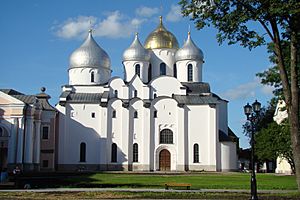
In 882, Oleg of Novgorod, Rurik's successor, took over Kiev. He then founded the state of Kievan Rus'. Novgorod was the second most important city in Kievan Rus' because of its size and influence. It was a tradition for the oldest son of the ruler in Kiev to govern Novgorod. If there was no son, local leaders called posadniks ruled the city.
Yaroslav the Wise was Prince of Novgorod from 1010 to 1019. He created the first written laws for the Eastern Slavs. These laws were later included in a larger law code called Russkaya Pravda. Yaroslav also gave the city special freedoms. His son, Vladimir of Novgorod, helped build the famous Saint Sophia Cathedral. This beautiful cathedral, also known as the Cathedral of Holy Wisdom, still stands today.
Early Connections with Other Countries
In old Norse stories, Novgorod was called the capital of Gardariki. Many Viking kings and leaders came to Novgorod for safety or work. These included Olaf I of Norway, Olaf II of Norway, Magnus I of Norway, and Harald Hardrada. A church dedicated to Saint Olaf was built in Novgorod soon after his death in 1030.
The town of Visby in Gotland was a major trading center in the Baltic Sea before the Hansa League. In 1080, merchants from Visby set up a trading post in Novgorod called Gutagard. Later, in the 13th century, German merchants also created their own trading station called the Peterhof. In 1229, German merchants in Novgorod received special rights, making their trade more secure.
The Novgorod Republic
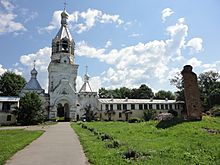
In 1136, the people of Novgorod removed their prince, Vsevolod Mstislavich. This year is seen as the start of the Novgorod Republic. The city could invite and dismiss princes for the next two centuries. However, powerful princes like Alexander Nevsky could still influence the city. The Novgorod Republic controlled much of northeastern Europe, from lands east of modern Estonia to the Ural Mountains. This made it one of the largest states in medieval Europe.
Important local leaders in Novgorod included the posadnik, or mayor. This official was chosen by the public assembly, called the Veche, from among the city's noble families, called boyars. The tysyatsky, or "thousandman," was also elected by the Veche. He was originally the head of the city's army but later handled business and legal matters. Another key figure was the Archbishop of Novgorod, who shared power with the boyars. Archbishops were elected by the Veche or by drawing lots.
The exact way the city-state was governed is not fully known. The boyars and the archbishop ruled together. The prince's power was less after the mid-12th century, but he was still important. He acted as a military leader and judge. Historians disagree on whether the Veche was truly democratic or controlled by the wealthy elite.
In the 13th century, Novgorod was a major trading hub for the Hanseatic League. It was the easternmost trading post, providing huge amounts of valuable furs like sable, ermine, and fox.
The city was also a center for culture during the Middle Ages. Many birch bark letters have been found, suggesting that many people could read and write. The Novgorod Codex, the oldest Slavic book found north of Bulgaria, was discovered here. Some of the oldest Russian chronicles were written in the archbishops' offices. The famous Novgorod merchant Sadko became a popular hero in Russian stories.
Novgorod was never conquered by the Mongols during their invasion of Rus'. The Mongol army turned back about 200 km from the city. This was likely because they did not want to get stuck in the marshy lands around the city. However, the grand princes of Moscow, who collected taxes for the Mongol khans, did collect tribute from Novgorod.
In 1259, Mongol tax collectors came to Novgorod. This caused unrest, and Alexander Nevsky had to punish some city officials. In the 14th century, Novgorod pirates, called ushkuiniki, raided as far as Kazan and Astrakhan. They helped Novgorod in its wars against the Grand Duchy of Moscow.
Novgorod was a major trade center during the time of Kievan Rus'. It was at the northern end of both the Volga trade route and the "route from the Varangians to the Greeks." Many goods were traded here. Scandinavian royalty often married Russian princes and princesses.
After the East–West Schism (when Christianity split), Novgorod fought against Swedish, Danish, and German crusaders starting in the 13th century. The Swedes invaded lands that had paid tribute to Novgorod. German knights, along with Danish and Swedish lords, launched attacks between 1240 and 1242. Novgorod sources say a Swedish army was defeated in the Battle of the Neva in 1240. The German campaigns failed after the Battle on the Ice in 1242. In 1293, the Swedes built the castle of Viborg in Karelia. On August 12, 1323, Sweden and Novgorod signed the Treaty of Nöteborg, which set their border for the first time.
In the 15th century, Novgorod faced severe food shortages for ten years. This greatly affected the people and the city's stability, leading to its decline. Novgorod was a trade hub, attracting many German merchants. About 200 German merchants lived there in the 1430s, making up about 1% of the population. Their presence influenced the city's economy and culture.
The city's decline was partly due to its inability to feed its large population. It depended on the Vladimir-Suzdal region for grain. The main cities in that area, Moscow and Tver, used this dependence to gain control over Novgorod. Finally, Ivan III took over the city for the Grand Duchy of Moscow in 1478. The Veche was dissolved, and many of Novgorod's nobles and merchants were sent to other parts of Russia. The Hanseatic League's trading post was closed in 1494, and its goods were seized by Moscow's forces.
Under the Tsardom of Russia
After being taken over, Novgorod became the third largest city in Muscovy and then the Tsardom of Russia. It had about 25,000 to 30,000 people in the 1550s. This lasted until the famine of the 1560s and the Massacre of Novgorod in 1570. During the massacre, Ivan the Terrible attacked the city, killed thousands of people, and sent its merchants and nobles to other cities. The late 16th century was better for the city. Boris Godunov brought back trade rights and improved the status of the Novgorod bishop. The German trading post reopened in 1603. Even after joining the Russian state, Novgorod kept its unique identity and customs. Some elected positions were quickly brought back after Ivan III had removed them.
During the Time of Troubles, Novgorod surrendered to Swedish troops in 1611. The city was returned to Muscovy six years later by the Treaty of Stolbovo. This conflict caused more people to leave the city. Novgorod only started to recover its wealth towards the end of the century. Important buildings like the Cathedral of the Sign and the Vyazhischi Monastery were built then. The famous Russian church leader Nikon was active in Novgorod between 1648 and 1652. Novgorod became a stronghold for Old Believers after the Great Russian Schism. The city remained an important trade center, even though Archangelsk became more prominent. Novgorod merchants traded in Baltic cities and Stockholm, and Swedish merchants came to Novgorod. Novgorod continued to be a major center for crafts, with over 200 different jobs in the 16th century. Bells, cannons, and other weapons were made there. Its silversmiths were famous for their special techniques used for religious items and jewelry. Novgorod chests were used all over Russia.
Russian Empire and Modern Era
In 1727, Novgorod became the administrative center of Novgorod Governorate within the Russian Empire. This division lasted until 1927. From 1927 to 1944, the city was part of Leningrad Oblast. Then, it became the administrative center of the new Novgorod Oblast.
On August 15, 1941, during World War II, the city was taken over by the German Army. Many of its historic monuments were destroyed. The Red Army freed the city on January 19, 1944. Out of 2,536 stone buildings, fewer than forty were left standing. After the war, the central part of the city was slowly rebuilt. In 1992, the main monuments of the city and its surroundings were added to the UNESCO World Heritage Site list. As of 2025, archaeological work continues there. In 1999, the city was officially renamed Veliky Novgorod. This helped avoid confusion with Nizhny Novgorod, a larger city east of Moscow.
Important Places to See
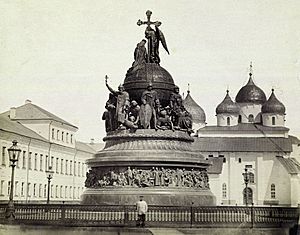
Veliky Novgorod is famous for its many old buildings from the Middle Ages. The most important is the Saint Sophia Cathedral. It was built between 1045 and 1050. Vladimir Yaroslavich, son of Yaroslav the Wise, helped fund it. Vladimir and his mother are buried there. It is one of the best-preserved churches from the 11th century. It is also likely the oldest building still used in Russia. Its design, with strong stone walls and five helmet-shaped domes, shows early Russian architecture. Its frescoes were painted in the 12th century and have been restored several times. The cathedral has famous bronze gates, which were possibly made in Germany in 1156.
The Novgorod Kremlin, also called the Detinets, is another key site. It has the oldest palace in Russia, called the Chamber of the Facets (1433). This was the main meeting hall for the archbishops. It also has the oldest Russian bell tower (mid-15th century) and the oldest Russian clock tower (1673). These buildings were first built by Archbishop Euphimius II.
Outside the Kremlin, there are three large churches built during the rule of Mstislav the Great. St. Nicholas Cathedral (1113–1123) has frescoes of Mstislav's family. It is located at Yaroslav's Court, which was once the main square. The Yuriev Monastery (one of Russia's oldest, 1030) has a tall, three-domed cathedral from 1119. A similar cathedral (1117) is in the Antoniev Monastery.
There are about fifty medieval and early modern churches in and around the city. Some were destroyed during the war and later rebuilt. The oldest designs are seen in churches like Saints Pyotr and Pavel (1185–1192) and Annunciation (1179). The Savior church at Nereditsa (1198) is considered a masterpiece of early Novgorod architecture.
In the 13th century, small churches with three-paddled designs were popular. Examples include a chapel at the Peryn Monastery (1230s). The next century saw new church designs, like St Theodor's church (1360–1361) and the Savior church on Ilyina street (1374). The Savior' church in Kovalevo (1345) was destroyed during the war. While the church has been rebuilt, its original frescoes have not.
After Ivan III took over Novgorod in 1478, the local architecture changed. New large buildings were designed by Moscow architects, similar to those in the Moscow Kremlin. However, some local churches still kept the traditional Novgorod style.
In Vitoslavlitsy, near the Yuriev Monastery, there is a museum of wooden architecture. It opened in 1964. More than twenty wooden buildings, including churches, houses, and mills, from the 14th to 19th centuries were moved there from around the Novgorod region.
There are also war cemeteries in Novgorod. About 11,400 graves of German soldiers and 1,900 soldiers of the Spanish Blue Division are buried there.
Transportation in Veliky Novgorod
Traveling Between Cities
Veliky Novgorod is connected to Moscow (531 km away) and St. Petersburg (189 km away) by the federal highway M10. You can take public buses to St. Petersburg and other places.
The city has direct train connections to Moscow, St. Petersburg, Minsk in Belarus, and Murmansk.
The city's old commercial airport, Yurievo, closed in 2006. The area is now a residential neighborhood. The Krechevitsy Airport has not had regular flights since the mid-1990s. There are plans to make Krechevitsy a new working airport by 2025. The closest international airport is St. Petersburg's Pulkovo, which is about 180 km north of the city.
Getting Around the City
Local transportation in Veliky Novgorod includes buses and trolleybuses. The trolleybus system started in 1995 and has five routes. It was the first trolley system to open in Russia after the fall of the Soviet Union.
Notable People from Veliky Novgorod
- Onfim (1220-1260) was a Russian artist and student. He is known for his notes, drawings, and homework scratched onto soft birch bark.
- Anton Stepanovich Arensky (1861-1906) was a great Russian composer, pianist, and conductor. He was an important figure in Russian music in the late 19th century.
- Sergei Vasilyevich Rachmaninoff (1873-1943) was a famous Russian composer, pianist, and conductor. His works, like the Second and Third Piano Concertos, are masterpieces performed worldwide.
- Gavrila Romanovich Derzhavin (1743-1816) was a notable Russian poet and statesman. His poems are known for their grand style and patriotic themes.
- Vitaly Valentinovich Bianki (1894-1959) was a Russian writer. He wrote many stories and fairy tales for children about nature. His books help kids learn about and love the world around them.
Sister Cities
Veliky Novgorod is twinned with these cities:
 Bielefeld, Germany
Bielefeld, Germany Kohtla-Järve, Estonia
Kohtla-Järve, Estonia Moss, Norway
Moss, Norway Nanterre, France
Nanterre, France Strasbourg, France
Strasbourg, France Rochester, New York, USA
Rochester, New York, USA Uusikaupunki, Finland
Uusikaupunki, Finland Watford, UK
Watford, UK Valga, Estonia
Valga, Estonia Zibo, China
Zibo, China
Images for kids
See also
 In Spanish: Veliki Nóvgorod para niños
In Spanish: Veliki Nóvgorod para niños



